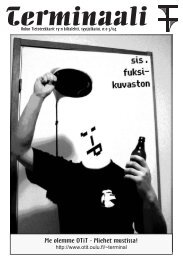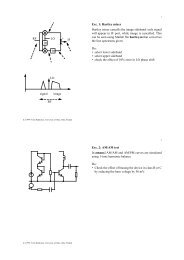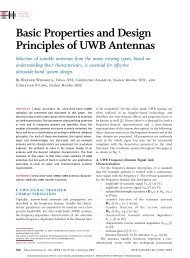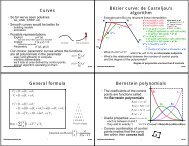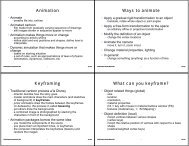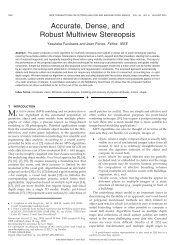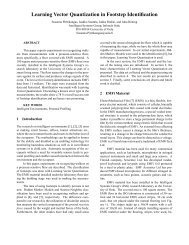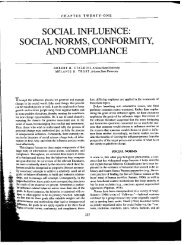On the Effect of Radio Channel Propagation Models - Oulu
On the Effect of Radio Channel Propagation Models - Oulu
On the Effect of Radio Channel Propagation Models - Oulu
Create successful ePaper yourself
Turn your PDF publications into a flip-book with our unique Google optimized e-Paper software.
lows or exceeds <strong>the</strong> FSL curve. This kind <strong>of</strong> behavior can<br />
be also extracted from route breakage figure (Figure 3).<br />
This phenomenon can be explained quite easily, if we recall<br />
<strong>the</strong> power attenuation behavior. The attenuation under<br />
FPL model is so strong that it effectively behaves nearly<br />
like a CP model, when <strong>the</strong> network traffic load is very low,<br />
since <strong>the</strong> interference power far away from <strong>the</strong> transmitter<br />
is almost negligible. However, as <strong>the</strong> network traffic is<br />
increased, <strong>the</strong> total interference power in <strong>the</strong> network is<br />
also increased, and as a consequence, it makes <strong>the</strong> CP approximation<br />
to fail with increasing traffic.<br />
Important metric from <strong>the</strong> application QoS perspective is<br />
<strong>the</strong> average end-to-end delay, which is presented in Figure<br />
5. Typical network behavior is seen: <strong>the</strong> delay stays constant<br />
at low traffic loads, but increases heavily when <strong>the</strong><br />
network becomes near to <strong>the</strong> limits <strong>of</strong> it's capability to<br />
handle traffic. Pushing even more traffic causes buffers to<br />
fill up, which finally leads to buffer overflows (<strong>the</strong> delay<br />
rise settles). We note that <strong>the</strong> used propagation model does<br />
not seem to have great impact to average delay, at least not<br />
at <strong>the</strong> low traffic load. At heavy traffic, <strong>the</strong>re are differences<br />
between <strong>the</strong> points, where <strong>the</strong> network starts to become<br />
unstable. CP-HP gives <strong>the</strong> lowest delay and FPL follows<br />
it at low traffic load. But, as in <strong>the</strong> case <strong>of</strong> packet loss<br />
(and route breakages), <strong>the</strong> delay <strong>of</strong> FPL starts to approach<br />
FSL as <strong>the</strong> traffic load is increased.<br />
>c O<br />
>. 0,0<br />
10 I.. ..,<br />
0,01<br />
Offered data traffic<br />
Figure 5. Average data packet delay (BC-MAC).<br />
B. IEEE 802.11 and Comparison to BC-MAC<br />
At <strong>the</strong> very high traffic loads, <strong>the</strong> performance differences<br />
between different cases can be clearly seen in throughput<br />
(Figure 6). In this figure, <strong>the</strong> FSL and CP-HP curves <strong>of</strong> <strong>the</strong><br />
802.11 and BC-MAC are shown. An interesting observation<br />
can be made when considering 802.11 curves. <strong>On</strong> <strong>the</strong><br />
contrary to BC-MAC results, 802.11 FSL gives better performance<br />
than 802.11 CP-HP! This is quite unexpected,<br />
but can be explained: The very nature <strong>of</strong> this result originates<br />
most likely form <strong>the</strong> well-known hidden-terminal<br />
problem. CSMA is based on power detection and a single<br />
transmission can be just detected at a distance <strong>of</strong> 250 m.<br />
10<br />
6 <strong>of</strong> 7<br />
However, when <strong>the</strong>re are several transmissions simultaneously<br />
at <strong>the</strong> different portions <strong>of</strong> <strong>the</strong> network, <strong>the</strong> cumulative<br />
power <strong>of</strong> <strong>the</strong>se transmissions can cause signals<br />
to be detected from far<strong>the</strong>r than 250 m. Therefore, this<br />
basically alleviates hidden-terminal problem as compared<br />
to <strong>the</strong> CP-HP case, in which <strong>the</strong> CSMA range is<br />
always 250 m, and shows a better throughput is a result.<br />
The same phenomenon also exists with BC-MAC, but<br />
<strong>the</strong> effect is only minor, since node-specific spreading<br />
codes and processing gain handle <strong>the</strong> situation.<br />
0.7<br />
0.6<br />
0.5<br />
D<br />
Ideal random channel access<br />
--802.11 (FSL)<br />
--802.11 (CP-HP)<br />
0.4 -R<br />
_sc'<br />
=3 . BC-MAC (FSL)<br />
s<br />
0.3<br />
BC-MAC (CP-HP)<br />
0.2<br />
0.1<br />
O 1-<br />
0.001 0.01 0.1 1<br />
Offered data traffic<br />
Figure 6. Average throughput (BC-MAC vs. 802.11).<br />
Offered data traffic<br />
1 .vrL nF+nn uu T<br />
0o0 )Q1<br />
,..<br />
0001 00<br />
. _..<br />
1 -1<br />
1 .OE-01 t<br />
, 1.0E-02<br />
-~eou<br />
1.0E-03<br />
1 .OE-04<br />
...- -.,.-802.11(FSL)<br />
-- - 80211(CPHP)<br />
. 1BCMAC 8021 (FSL)<br />
BC-MAC (CP-HP)<br />
1.OE-05<br />
Figure 7. Average packet loss ratio (BC-MAC vs.<br />
802.11).<br />
This interesting phenomenon affects only at <strong>the</strong> high<br />
traffic load as seen from <strong>the</strong> packet loss behavior (Figure<br />
7). 802.11 CP-HP clearly dominates <strong>the</strong> performance<br />
over <strong>the</strong> 802.11 FSL case at low traffic load. But, as <strong>the</strong><br />
traffic load is increased, <strong>the</strong>re will be more and more<br />
simultaneous transmissions at <strong>the</strong> different parts <strong>of</strong> <strong>the</strong><br />
network, and hence, <strong>the</strong> phenomenon is enhanced. From<br />
about <strong>the</strong> traffic load <strong>of</strong> 0.08 forward, <strong>the</strong> performance<br />
under FSL is better than under CP-HP. As a consequence,<br />
commonly used CP-HP model clearly fails,<br />
since it gives too optimistic results at <strong>the</strong> low traffic load<br />
and too pessimistic at <strong>the</strong> high traffic load.<br />
10




